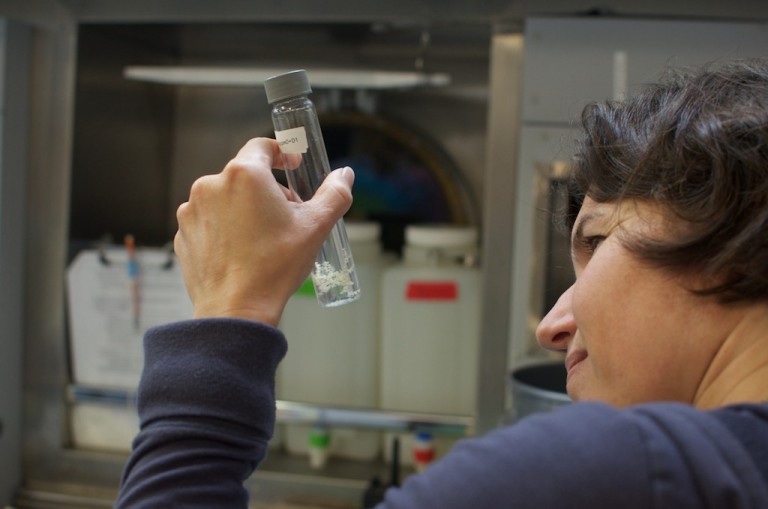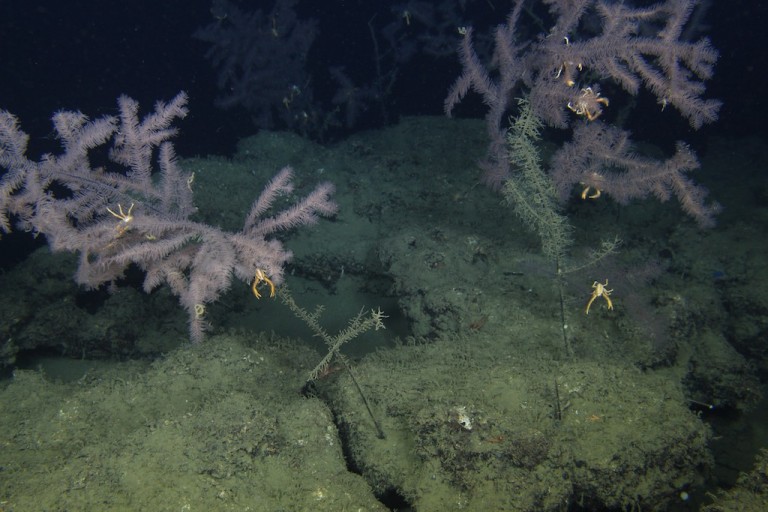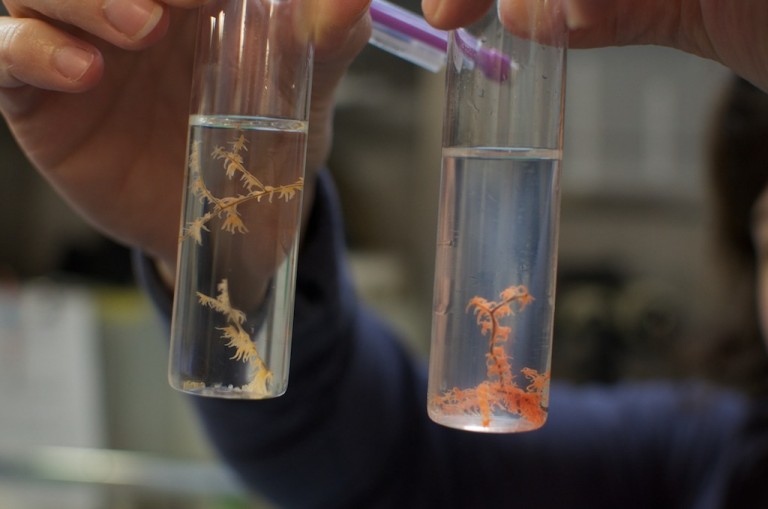The weather was too rough for deploying any instruments today. But the science team continued to work on experiments in the lab.

Molecular ecologist Dr. Iliana Baums and graduate student Danielle Young worked into the late hours to complete a four-day experiment on deep-sea corals that were collected on the first ROV dive. Corals live as colonies of genetically identical polyps organized with a calcareous skeleton. The individual polyps look like miniature jellies, a close relative. Coral polyps extend into the water column to catch food particles drifting by. Deep-sea and cold water corals differ from shallow-water, reef-building corals that have symbiotic algae living inside their tissues that help provide food.
Two different deep-sea coral species were collected here in the northern Gulf of Mexico: an octocoral Callogorgia and a hexacoral Leiopathes. The researchers were successful in keeping the specimens alive in the laboratory, a non-trivial issue when working with deep-sea animals whose natural habitat is lightless, cold, and under pressure.
Their experiment involved exposing the specimens to different dilutions of oil from the Macondo wellhead and the chemical dispersant that was poured into the ocean to mitigate the spill during the summer of 2010. Over the four-day period, Iliana and Danielle examined each test tube (72 tubes per species) and documented visible changes in the coral and any other signs of stress. Corals show environmental stress in a limited number of ways. They can retract their polyps, drop their polyps, slough off tissue, and produce mucous.
The researchers are developing tools to tell which genes in the coral turn on or off depending on what stressors the coral is being exposed to. They are trying to figure out what happens to the coral when it is stressed by oil, oil plus dispersant, and by dispersant alone. They can then look for the genetic response and hopefully create a marker to diagnose it. A good way to think about this in a more familiar context is to consider human medicine. Your doctor may have you get a blood test when you are sick. The doctor interprets your symptoms with the results of the blood test to come up with a diagnosis of the illness (the stressor) on your body. For example, symptoms of fatigue and a low level of iron in your blood might be diagnosed as anemia.

The ship-based part of the experiment ran for four days, with daily observations and record taking. At the end of the experiment last night, Iliana and Danielle prepared the samples for further analysis in the laboratory back at Penn State and Temple University. Fragments from each test tube were placed in even smaller tubes and treated with a special salt solution that preserves genetic material. The tubes were placed into a -80°C freezer for storage while onboard. This procedure essentially freezes the physiological state of the coral so that the researchers can determine what genes were turned on at this point in time.
None of this genetic analysis would have been possible 20 years ago. Now with modern, less expensive, next-generation sequencing, researchers have been able to create genetic catalogs of a broad range of species, like these corals. Samples of Leiopathes and Callogorgia that were collected prior to this cruise have been sequenced so that the researchers know all of the possible genes that could be turned on for these species.

Iliana and Danielle did observe responses in their samples with the different treatments. But it is too early to draw any conclusions until they complete the full analyses back at shore.
Iliana concluded the day with a presentation for the traditional Schmidt Ocean Institute Seminar at Sea onboard R/V Falkor. She discused her studies of corals from all around the globe and the genetic tools used to understand their responses to stresses. We learned about stress conditions acting upon corals in shallow waters—such as global warming and ocean acidification—and the impacts such phenomena may have upon deep-sea corals.
Everyone is anticipating better weather tomorrow and the ROV dive at the “Megaplume” site.
